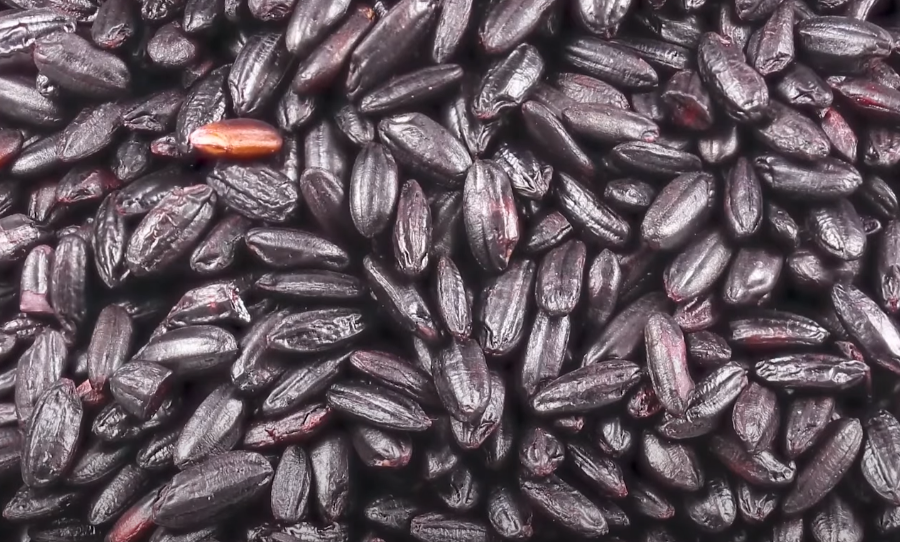Rice (Oryza sativa L.) is the major cereal crop in most of the developing countries. Black rice is a type of pigmented rice, with black bran, covering the endosperm of the rice kernel. Black rice is an aromatic and pigmented rice variety popular in Asia, whose demand and consumption is increasing day by day in Bangladesh, as well as in the world due to its numerous health benefits.
Black rice is grown under rainfed condition in both upland and lowland rice ecosystem. It is not consumed as staple food but consumed as the functional foods, because of its anthocyanin content, acts as major bio-active compound. Accumulation of anthocyanin (Cyanidin-3-glucoside, cyanidin-3-rutinoside, and peonidin-3-glucoside) in the pericarp, tegmen, and aleurone layer, promotes black color to rice grains. Anthocyanins are water soluble pigment, which is responsible for the antioxidative, and anti-inflammatory properties of black rice. It has potential use in nutraceutical or functional food formulation.
“A spoonful of black rice bran contains, more health promoting anthocyanin antioxidants than in a spoonful of blueberries, but with less sugar, more fiber, and Vitamin E antioxidants.”
-Dr. Zhimin Xu
Rice (Oryza sativa L.) is the staple food for more than half of the world’s population. Rice is of different types, based on the size of grains, texture, aroma, maturity duration, growing environment and colour (polished, black, red, white and brown). The colored rice varieties are considered to have numerous health benefits.
Black rice (Oryza sativa L. indica), is a special cultivar of rice, which contains remarkably high anthocyanin pigments in the aleurone layer than white and red rice, which account for its violet or dark purple color. Black rice is almost six times richer in antioxidant activities, have high protein content (8.16%) and low fat content (0.07%), as compared with other rice varieties, is gluten free, gut friendly and a natural cleaner with many medicinal values.
Black rice contains essential amino acids, like: lysine, tryptophan, functional lipids, dietary fibre, vitamins, such as: vitamin B1, vitamin B2, vitamin E, folic acid and phenolic compounds (γ-oryzanols, tocopherols, Tocotrienols. It has a mild nutty flavor and is slightly sticky when cooked. It is rich in macro and micro nutrients, including iron, zinc, calcium, phosphorus, and selenium, and low in calories. Black rice is rich in nutrients and protein content, compared with the other varieties of rice grown in Bangladesh. It is often mixed with white rice before cooking, to increase flavor, quality, and palatability.
Due to higher fiber content it has lower digestibility, takes more time to cook than white rice, and feels rubbery, while chewing. To overcome this, black rice is parboiled to reduce cooking time and improve the textural quality of grains, but color might be lost during this process.
In recent time, it has become popular in food, cosmetic, nutraceutical and pharmaceutical applications owing to its numerous health benefits. Black and red rice is resistance to insect and pest than the brown rice.
In black rice anthocyanins are found in higher concentrations than in dark fruits, such as blueberries, blackberries, dark grapes, and dark cherries. Hence, it is better source of antioxidants than blueberry.
History
Black rice has been consumed for centuries in Asian countries, such as: China, Korea and Japan. It has been reported that black rice has greater antioxidant activity than white rice. In Asian countries, China and Indonesia common people were not allowed to store/ cultivate/consume black rice during imperial period without permission of the authorities and was solely consumed by royals and elite personalities and used as a tribute food.
Potential benefits of black rice
Farmers can be benefited from better market value and increased farm income due to its multi-nutritional quality, and it will encourage farmers for its cultivation widely. Black rice consumption can mitigate the need of cereal with high nutritional status. It presents a great importance in the food industry, due to the high content of Polyphenols, which can be isolated as fractions, to use them as functional colorants or as food ingredients.
Constraints in black rice production
Utilization of black rice as a product is still minimal in Bangladesh. The potential of black rice is not yet optimally utilized, which is one of the inhibiting factors for its low productivity. It is less popular among farmers, due to its inherent undesirable traits, such as: low yield, highly photo-insensitive, longer vegetative phase, tall stature, are the main reason behind its un-adoption among farmers. Lower productivity and higher price are the reason, behind in accessibility of nutrient enriched black rice by common people.
Future aspects
Black rice has already been cultivated in hilly areas in Bangladesh, limitedly. It has also been cultivated in comilla and khulna districts. The farmers related to these are seeing success in their efforts. They have profited economically as well. Bangladesh needs to focus on this variety of rice and make this available everywhere in the country. Black rice has great prospect in Bangladesh, and in the future, it might play a significant role in the agricultural sector in Bangladesh.
Citation:
SHIVANI KUMARI,
Department of Agronomy, SASRD, Nagaland University, Medziphema (Nagaland).


